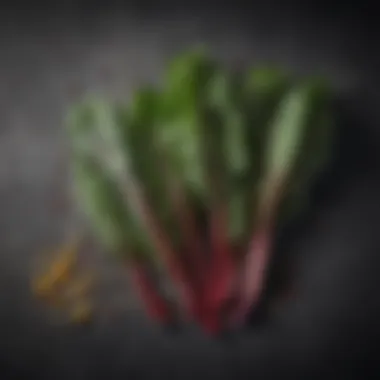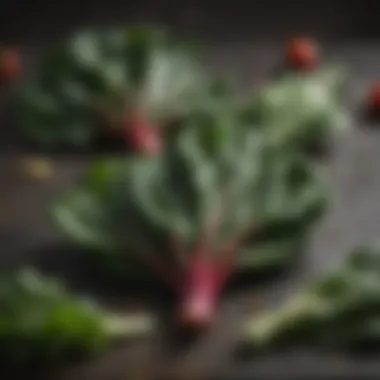Comprehensive Guide to Cooking Swiss Chard


Intro
In the realm of leafy greens, Swiss chard often does not receive the attention it deserves. This nutrient-dense vegetable boasts vibrant colors and a unique flavor profile, making it a valuable addition to numerous dishes. As we delve into the world of Swiss chard, this guide aims to enhance your understanding of its culinary possibilities.
Swiss chard stands out for many reasons. It contains rich vitamins and minerals, contributing to various health benefits. Its versatility allows it to be included in salads, soups, and sautéed dishes. Furthermore, learning how to properly select, prepare, and cook Swiss chard can elevate your cooking skills and diversify your meal planning.
This guide comprehensively covers the nutritional aspects, cooking methods, and specific recipes that showcase Swiss chard in its best light. So, whether you are looking to add a new vegetable to your repertoire or enhance your existing dishes, Swiss chard could be the ideal candidate. From its preparation techniques to delicious recipes, our aim is to highlight the many ways you can incorporate this often-overlooked green into your meals.
For the discerning food lover, understanding the nuances of Swiss chard can greatly enhance the culinary experience. This guide will navigate from the initial selection of Swiss chard at your local market to the final plating of a beautifully executed dish, ensuring you revisit Swiss chard time and again in your culinary endeavors.
Prelude to Swiss Chard
Swiss chard is a leafy green vegetable that plays an important role in various cuisines around the world. Understanding Swiss chard sets a strong foundation for exploring its culinary uses and nutritional benefits. This section aims to provide background knowledge about the vegetable, enriching the reading experience and preparing the audience for deeper content in subsequent sections.
What is Swiss Chard?
Swiss chard, scientifically known as Beta vulgaris subsp. cicla, is a member of the amaranth family. It is characterized by its broad, dark green leaves and vibrant stalks that can be found in various colors, including white, yellow, and red. This green can be cultivated in various climates, contributing to its widespread popularity.
This vegetable is commonly mistaken for spinach due to its similar appearance. However, Swiss chard has a unique flavor and texture, with a slightly earthy taste that is balanced by a mild bitterness. It offers versatility in cooking, enhancing both simple and complex dishes.
Culinary History of Swiss Chard
The history of Swiss chard dates back to ancient times. It was first cultivated by the Mediterranean people, who appreciated its agricultural resilience and nutritional value. The name “Swiss” does not refer to its origin; rather, it is attributed to the Swiss botanist Karl Friedrich von Gaisberg, who played a crucial role in studying the plant in the 19th century.
Over the centuries, Swiss chard has been embraced in various cultures. In Mediterranean cuisines, it is often used in salads, stews, and as a filling for pastries. In American cooking, it gained popularity in the 20th century as a backdrop to a range of hearty meals. Today, Swiss chard is celebrated for its culinary ease and significant nutritional benefits, making it a staple in many kitchens.
"Swiss chard is not just a vegetable; it is a food with historical significance and culinary versatility."
This foundation prepares the cook to appreciate how to select, prepare, and cook Swiss chard, leading to a deeper engagement with this underrated vegetable.
Nutritional Profile of Swiss Chard
Understanding the nutritional profile of Swiss chard is essential for anyone looking to enhance their dietary habits. This leafy green vegetable is not only low in calories, but it is also packed with vitamins, minerals, and dietary fiber. Incorporating Swiss chard into your meals can significantly contribute to overall health. Its rich nutrient content supports various bodily functions, including metabolic processes and immune system health. Furthermore, the nutritional profile of Swiss chard makes it versatile for multiple culinary approaches, ensuring that home cooks can benefit from it in diverse recipes.
Vitamins and Minerals
Swiss chard is an excellent source of vital vitamins and minerals. One serving can provide substantial amounts of the following nutrients:
- Vitamin K: Essential for blood clotting and bone health. Swiss chard contains a remarkable amount of Vitamin K, surpassing the daily recommended intake in just one cup.
- Vitamin A: Important for eye health, immune function, and skin health. The vibrant green color of the leaves is indicative of its high beta-carotene content, which the body converts into Vitamin A.
- Vitamin C: Known for its antioxidant properties, Vitamin C in Swiss chard helps protect the body from free radical damage, supports the immune system, and aids in the absorption of iron from plant foods.
- Magnesium: This mineral is crucial for muscle function and energy production. Swiss chard provides a good amount of magnesium, which can help in regulating blood pressure and supporting bone health.
- Potassium: Vital for proper cell function and helps maintain healthy blood pressure levels. Again, Swiss chard excels in potassium content, offering benefits for heart health.
Swiss chard is more than just a leafy green; its dense nutritional profile makes it a superfood in its own right, beneficial for those seeking a healthy lifestyle.
Health Benefits
The health benefits of Swiss chard extend well beyond its nutritional makeup. Here are some of the key advantages:


- Antioxidant Properties: Swiss chard is rich in antioxidants such as flavonoids and polyphenols. These compounds help fend off oxidative stress, reducing the risk of chronic diseases.
- Bone Health: With high levels of Vitamin K, magnesium, and calcium, Swiss chard promotes bone density and overall skeletal strength.
- Heart Health: The potassium content can aid in regulating blood pressure, while fiber supports heart health by helping to manage cholesterol levels.
- Weight Management: Low in calories but high in fiber, Swiss chard can be a valuable addition to a weight-loss diet. Its fiber content can promote satiety, making one feel full for longer.
- Blood Sugar Control: Some studies suggest that the antioxidants and phytonutrients in Swiss chard might help improve insulin sensitivity and regulate blood sugar levels, beneficial for individuals with diabetes or insulin resistance.
Overall, the inclusion of Swiss chard in a regular diet can lead to numerous health benefits, promoting well-being and helping prevent various health issues. It is not merely a food choice; it is an investment in communal health.
Selecting Swiss Chard
Selecting Swiss chard is essential for achieving the best flavor and texture in your dishes. This leafy vegetable can vary greatly in quality, which influences not only its taste but also its nutritional value. Understanding how to select Swiss chard properly will enhance your cooking experience and ensure that you are getting the most out of this nutritious green.
Choosing Fresh Chard
When you are in the market for Swiss chard, look for leaves that are crisp and vibrant. Fresh chard should have a rich green color, free from any yellowing or browning. The stems come in a variety of colors, such as white, red, and yellow. Regardless of the hue, the stems should be firm and not wilted. If the leaves appear dry or have dark spots, they may be past their prime and not suitable for consumption.
Look closely at the size of the leaves as well. Smaller leaves tend to be more tender and less bitter than larger ones, making them ideal for salads or light dishes. However, if you need the chard for cooking, larger leaves can be appropriate as they hold up well in various cooking methods.
Also, consider the season. Swiss chard is typically in season during the cooler months, which often means fresher produce. If possible, buy it from local farmers' markets, where it is more likely to be fresh and recently harvested.
Storage Techniques
Once you have chosen fresh Swiss chard, proper storage is key to maintaining its quality. First, it’s important to avoid washing it before storing, as moisture can lead to spoilage. Instead, store the chard unwashed in a perforated plastic bag or wrapped in a damp paper towel. This method helps control moisture while allowing it to breathe.
Swiss chard can be kept in the vegetable crisper drawer of your refrigerator. Under optimal conditions, it will last for about 5 to 7 days. After this period, the leaves may start to become limp, and you should consider using them promptly in your dishes.
If you find yourself with an abundance of chard, freezing is an option. Blanch the leaves in boiling water for a few minutes, then immediately plunge them into ice water. After draining, place them in airtight containers or freezer bags. Frozen Swiss chard can last up to 10 months, providing you quick access to this nutritious green when you need it.
"Quality selection and proper storage of Swiss chard are fundamental for maximizing its health benefits and enhancing meal preparation."
Familiarizing yourself with these selections and storage tips will lead to better cooking outcomes and a greater appreciation for Swiss chard. Incorporating this leafy green into your meals becomes more accessible when you understand how to choose and store it correctly.
Preparing Swiss Chard
Preparing Swiss chard is a crucial step in utilizing this leafy green effectively in your cooking. Proper preparation maximizes flavor, nutrition, and the overall eating experience. Swiss chard can be somewhat tough if not prepared correctly, and understanding how to clean and cut it will enhance its texture and taste. Beyond that, these initial steps ensure that the chard is free from any impurities and fits well into various recipes.
Cleaning Swiss Chard
Cleaning Swiss chard is essential to remove dirt and any possible insects. Given that chard grows close to the ground, it often harbors soil particles in its folds. Here is a detailed approach to effectively clean Swiss chard:
- Rinse Under Cold Water: Start by rinsing the leaves under cold running water. Slowly glide the leaves apart while washing to let water reach the inner folds.
- Soak in a Bowl: For thorough cleaning, consider soaking the chard in a bowl of cold water. This allows dirt to settle at the bottom. Let it soak for about 5 to 10 minutes.
- Shake Off Excess Water: After soaking, gently shake the leaves to remove excess water. Be sure not to be too rough to avoid bruising the delicate leaves.
- Drying: Place the rinsed leaves on a clean kitchen towel or use a salad spinner to remove remaining moisture. This is particularly important if you plan to sauté or stir-fry the chard, as excess water can affect cooking.
"A well-cleaned Swiss chard not only tastes better but also looks appealing on the plate."
Removing Stems and Leaves
Removing the stems and separating the leaves from Swiss chard is another key task in its preparation. The stems, while edible, can be quite fibrous and may require different cooking times than the leaves.
- Identify the Stem and Leaf: Hold the stalk of the chard with one hand. The leaf will naturally fall away from the stem.
- Cutting the Stems: Use a sharp knife to slice the stem at the base where it meets the leaf. If the stems are thick, you might want to remove these fibrous parts entirely or chop them into smaller pieces for even cooking.
- Storing Separated Parts: If you choose to use the stems later, store them separately. Keeping them in a damp paper towel within a plastic bag helps maintain their freshness until you are ready to cook.
- Cooking Considerations: Be mindful that the leaves cook faster than the stems. Thus, if you use both, add the stems to the pan first, letting them sauté, and then introduce the leaves a few minutes later.
Following these steps ensures you prepare Swiss chard efficiently, readying it for a variety of dishes. As you become more familiar with the nuances of Swiss chard preparation, it will surely become a staple in your kitchen.


Cooking Techniques for Swiss Chard
Understanding the right cooking techniques for Swiss chard is essential for optimizing its nutritional value and enhancing its flavors. Each method offers unique benefits, making Swiss chard a versatile ingredient in many dishes. Cooking techniques can change the texture and taste of this leafy green, allowing it to complement various recipes. Moreover, how you cook Swiss chard can also affect its nutrient retention. Here, we will explore several cooking methods, including boiling, sautéing, steaming, baking, and grilling, discussing their specific advantages in preparing this remarkable vegetable.
Boiling and Blanching
Boiling Swiss chard is a quick method that helps to soften its texture. While boiling, it’s important to add salt to the water, as this enhances the flavor. When the water is at a rolling boil, add washed Swiss chard and let it cook for about two to three minutes. This process helps to retain vibrant color. After boiling, quickly drain and shock the greens in ice-cold water. This technique, known as blanching, preserves the color, texture, and nutrients.
It's worth noting that overcooking can lead to a loss of flavor and nutritional benefits, so timing is crucial. Blanched chard can be used in salads, stir-fried dishes, or as a side vegetable.
Sautéing
Sautéing Swiss chard is a popular cooking method that intensifies its earthy flavors and brings out natural sweetness. Begin by heating oil in a skillet. Olive oil works well, but other oils can also be considered. When the oil is hot, add chopped garlic or onions for added flavor, followed by chopped Swiss chard. As it cooks, the leaves will wilt in a short time, around five to seven minutes.
This method allows you to combine Swiss chard with other ingredients, such as nuts, cheeses, or proteins, creating a more complex dish. Sautéing can create a lower-fat option to indulge in the rich flavors without compromising on health benefits.
Steaming
Steaming is another excellent technique for cooking Swiss chard, mainly because it helps retain most of its nutrients. This is key for health-conscious cooks who want to maximize the benefits of this leafy green. In a steamer basket above boiling water, place cleaned chard leaves and cover. The cooking time will be around five minutes.
This method ensures that the Swiss chard remains tender while retaining its vibrant color and nutritional content. Steamed Swiss chard can be served as a side dish or added to pasta and grain dishes for extra nutrition.
Baking
Baking Swiss chard brings an alternative texture and flavor to the vegetable. Chard pairs well with various seasonings. Wrap it in aluminum foil with some olive oil, garlic, and herbs, then bake it at 375°F for around 20 to 25 minutes. The baking process can enhance the flavors, making it a comforting side dish.
Additionally, Swiss chard can be incorporated into stuffed dishes, such as quiches or casseroles. Baking allows for creative applications while keeping its distinct flavor intact.
Grilling
Grilling Swiss chard offers a smoky flavor that can elevate any dish. Start by brushing whole leaves with olive oil and seasoning them with salt and pepper. Grill the leaves on medium heat for two to three minutes on each side. This method adds a unique charred taste while maintaining a pleasant texture.
Grilled chard can serve as a complement to meats or can be a stand-alone side, enhancing both visual appeal and flavor in a meal. The grill also allows the moisture in the leaves to trap the heat, resulting in a tender finish.
Cooking techniques significantly influence the quality and flavor of Swiss chard, making it crucial to choose the appropriate method based on desired outcomes.
Recipes Featuring Swiss Chard
The inclusion of recipes featuring Swiss chard is crucial in this article as it highlights the versatility of this leafy green. Not only does Swiss chard offer numerous nutritional benefits, but it also possesses unique flavors and textures that can enhance a variety of dishes. These recipes are an opportunity to explore how Swiss chard can be integrated into both simple and sophisticated meals, making it accessible to home cooks of all skill levels. Utilizing this vegetable can elevate everyday recipes, presenting a chance to enjoy its health benefits while experiencing its culinary potential.
Swiss Chard Salad
A Swiss chard salad is an excellent way to showcase the freshness and vibrant colors of this green. Begin with completely washed Swiss chard leaves. Use a mixture of both leaves and the tender parts of the stems to add a crunchy element. Combine the chard with a light vinaigrette made from olive oil, lemon juice, salt, and pepper to create a refreshing dish. Consider adding sliced almonds, feta cheese, or seasonal fruits like oranges or apples for additional flavor. This salad can serve as a nutritious side or a light main dish, celebrating the earthy flavors of the chard.
Swiss Chard Pasta Dish


Incorporating Swiss chard into pasta dishes is a practical way to enhance a familiar favorite. Sauté chopped garlic in olive oil until fragrant, then add sliced Swiss chard to the pan. Cook until the leaves are wilted before mixing in cooked pasta. A sprinkle of Parmesan cheese can further enrich this dish. The addition of sautéed Swiss chard not only improves the dish's nutritional profile but also introduces a satisfying texture. This recipe is flexible, allowing the addition of other ingredients like mushrooms or olives for varied flavor profiles.
Swiss Chard Quiche
Quiche provides another fantastic avenue to utilize Swiss chard. Consider preparing a base with eggs, cream, and cheese. Mix in sautéed Swiss chard along with onions or leeks for depth. The chard not only complements the quiche's rich ingredients but also provides a pop of color. Bake until set and golden. This dish can easily transition from breakfast to dinner, making it suitable for any occasion. The combination of flavors makes this recipe a comforting yet refined option.
Sautéed Swiss Chard with Garlic
Sautéed Swiss chard with garlic is a simple yet flavorful side dish. Heat olive oil in a pan and add minced garlic until it’s fragrant but not browned. Toss in chopped Swiss chard and cook until wilted and tender. Season with salt and pepper, and a splash of lemon juice can elevate the dish further. This straightforward preparation allows the natural flavors to shine through while retaining the chard's vibrant color and nutrients. It pairs nicely with meats or can be enjoyed as a standalone vegetarian dish.
Swiss Chard Stir-Fry
For a quick and nutritious meal, a Swiss chard stir-fry is ideal. Begin by sautéing your choice of protein, such as chicken or tofu, in a hot pan. Once mostly cooked, add sliced Swiss chard, bell peppers, and carrots. The key is to stir-fry at high heat to maintain the vegetables' crunch. Season with soy sauce or teriyaki sauce for a savory finish. This dish highlights the versatility of Swiss chard as it easily absorbs the flavor of sauces, making it a delightful addition to any stir-fry.
Pairing Suggestions
Pairing Swiss chard with other foods amplifies its flavors and enhances overall dining experience. Understanding which ingredients or drinks complement Swiss chard is essential for anyone looking to elevate their culinary skills. By selecting the right pairings, you can create dishes that are not only delicious but also satisfying and balanced. The depth of flavor in Swiss chard allows it to shine brightly when combined with other items, and the pairing suggestions in this section look at both beverages and ingredients.
Wine Pairings
Choosing the right wine can significantly elevate a meal featuring Swiss chard. White wines, particularly those with bright acidity, work well. For instance, a Sauvignon Blanc offers notes of citrus, which contrast nicely with the earthiness of the chard. A Grüner Veltliner is another excellent choice, bringing peppery flavors that can enhance the vegetable's natural taste. Both wines are light and refreshing, making them suitable companions for a variety of Swiss chard dishes.
For heartier meals that include Swiss chard, consider a light red wine like Pinot Noir. Its berry notes add a distinctive contrast, while its acidity helps to cut through the richness of the dish. Always remember to serve these wines slightly cooler to highlight their refreshing qualities.
Complementary Ingredients
When preparing dishes with Swiss chard, selecting the right complementary ingredients is vital. Here are some suggestions:
- Garlic: Adds aromatic depth and enhances the overall flavor profile. Sauté it with the chard for a fragrant dish.
- Lemon: The acidity from lemon juice brightens up the taste, balancing the vegetable's earthiness. A squeeze can elevate any dish.
- Nuts: Toasted pine nuts or walnuts add a crunchy texture and their oils harmonize well with Swiss chard. They bring out the richness without overpowering.
- Cheese: Feta or goat cheese offers contrasting creaminess and saltiness. They can be crumbled over salads or mixed into baked dishes.
- Olive oil: A drizzle of high-quality extra virgin olive oil is a simple way to enhance flavor and give a luxurious mouthfeel.
By combining Swiss chard with these ingredients, you can create dishes that are rich and varied, appealing to the palate on multiple levels.
"Pairing Swiss chard correctly can turn a simple meal into a culinary delight, showcasing its versatility and enhancing the dining experience."
Overall, understanding the role of pairings will not only improve your cooking but will also deepen your appreciation for Swiss chard and its unique qualities.
Ending
The conclusion of our exploration into Swiss chard encompasses more than just a summary. It underlines the significance of this vegetable in modern kitchens. Swiss chard is esteemed not only for its diverse flavors but also for its substantial health benefits. Integrating Swiss chard into your cooking routine presents numerous advantages, including enhancing nutritional intake and adding complexity to dishes.
Embracing Swiss Chard in Your Cooking
To truly embrace Swiss chard in your culinary repertoire, one must go beyond mere substitution. It is essential to experiment with its unique flavors and textures. By using Swiss chard in various cooking techniques, such as sautéing, grilling, and baking, cooks can unlock new profiles in their meals.
Consider incorporating Swiss chard into traditional dishes. For instance, instead of spinach in a quiche or pasta, Swiss chard offers a richer taste and is equally nutritious. Adding it to soups and stews elevates the visual appeal and boosts health benefits without requiring significant adjustments to standard recipes. Additionally, the cooking process may be adapted based on how the leaves and stems complement other ingredients.
Final Thoughts
As we conclude, it is apparent that Swiss chard deserves a place in every kitchen. Its versatility is matched by its health merits, making it an ideal investment for both novice and experienced cooks. Experimenting with Swiss chard can lead to unexpected culinary treasures. This leafy vegetable invites creativity and offers boundless opportunities.
Incorporating Swiss chard not only enhances the dish but also promotes a healthier diet. Choose to explore and abandon the notion that only familiar vegetables can shine in your meals.
By recognizing the potential of Swiss chard, you open doors to a wider array of flavors and boost your overall culinary skills. Take this knowledge and begin your journey with Swiss chard. The possibilities are indeed plentiful.







